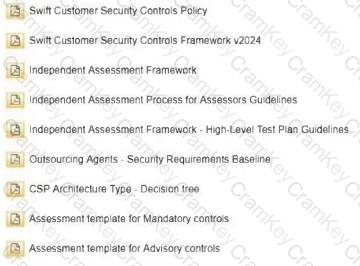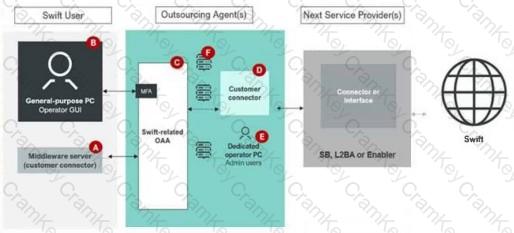The "SWIFT footprint" refers to the extent of SWIFT-related infrastructure (hardware, software, and connectivity components) that a user must manage within their environment. A smaller footprint means less local infrastructure to maintain, typically achieved through cloud-based or managed services. Let’s evaluate each option:
•Option A: Full stack of products up to the Messaging Interface
This refers to an on-premises deployment where the user manages a complete set of SWIFT components, including the messaging interface (e.g., Alliance Access), communication interface (e.g., Alliance Gateway), SwiftNet Link (SNL), HSM, and VPN boxes for connectivity to the SWIFT network. This setup requires significant local infrastructure, including servers, security devices, and network components, resulting in a large SWIFT footprint.
•Option B: Alliance Remote Gateway
Alliance Remote Gateway (ARG) is a service where the Alliance Gateway is hosted remotely by SWIFT or a third party, but the user still maintains a messaging interface (e.g., Alliance Access) locally. While this reduces the footprint slightly by outsourcing the communication interface, the user still manages the messaging interface, HSM, and local connectivity components, resulting in a moderate footprint.
•Option C: Lite 2 or Alliance Cloud
This is the correct answer. Alliance Lite2 and Alliance Cloud are cloud-based solutions designed for smaller institutions or those seeking a minimal local footprint. In Alliance Lite2, the user connects to SWIFT via a lightweight client (Alliance Lite2 AutoClient) or a browser-based interface, with most infrastructure (e.g., messaging interface, communication interface, HSM) hosted by SWIFT in the cloud. Alliance Cloud similarly hosts the full SWIFT stack (including Alliance Access and Alliance Gateway) in a SWIFT-managed cloud environment, requiring only minimal local infrastructure (e.g., a secure connection to the cloud). This results in the smallest SWIFT footprint, as the user manages very little on-premises infrastructure. The CSCF still applies, but many controls are managed by SWIFT (e.g., "1.1 SWIFT Environment Protection").
•Option D: A user with a Messaging Interface behind a Service Bureau
A Service Bureau is a third-party provider that hosts SWIFT infrastructure (e.g., Alliance Gateway, SNL) for multiple users, but the user still maintains a local messaging interface (e.g., Alliance Access) to connect to the Service Bureau. This setup reduces the footprint compared to a full on-premises deployment, as the user does not manage the communication interface or network connectivity components. However, the local messaging interface and associated security components (e.g., HSM) still constitute a larger footprint than a fully cloud-based solution like Alliance Lite2 or Alliance Cloud.
Summary of Correct Answer:
Alliance Lite2 or Alliance Cloud (C) has the smallest SWIFT footprint, as most infrastructure is hosted in the cloud by SWIFT, minimizing the user’s local management responsibilities.
References to SWIFT Customer Security Programme Documents:
•SWIFT Customer Security Controls Framework (CSCF) v2024: Control 1.1 applies to cloud deployments like Alliance Cloud, reducing the user’s local footprint.
•SWIFT Alliance Lite2 Documentation: Describes the minimal infrastructure required for Lite2 users.
•SWIFT Alliance Cloud Documentation: Highlights the fully hosted nature of the solution, minimizing the SWIFT footprint.
========

